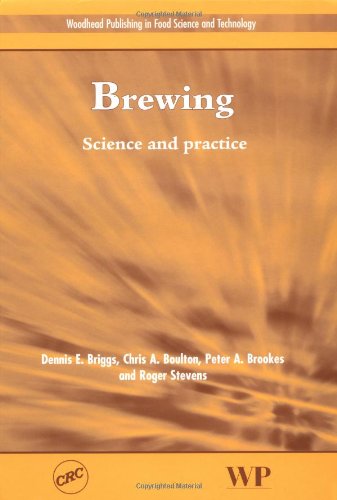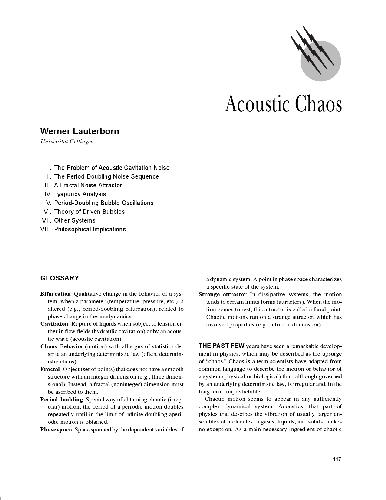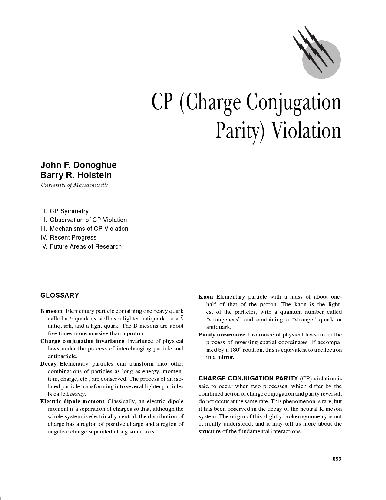Dennis E. Briggs, Chris A. Boulton, Peter A. Brookes, Roger Stevens9780849325472, 0849325471
After an initial overview of the brewing process, the book reviews malts, adjuncts, and enzymes. Chapters explain water, effluents, and wastes; detail the science and technology of mashing, including grist preparation; discuss hops and are followed by chapters on wort boiling, clarification, and aeration. Additional chapters present information on yeast biology, metabolism, and growth; fermentation, fermentation technologies, and beer maturation; and native African beers. After a discussion of brewhouses, the authors consider a number of safety and quality issues, including beer microbiology and the chemical and physical properties of beer, which contribute to qualities such as flavor. A final group of chapters cover packaging, storage, distribution, and the retail handling of beer.
Based on the authors’ unrivaled experience in the field, Brewing: Science and Practice will be a standard work for the industry.
Table of contents :
Front Matter……Page 1
Preface……Page 3
Table of Contents……Page 0
Table of Contents……Page 5
1.2 Malts……Page 21
1.5 Milling and Mashing in……Page 22
1.6 Mashing and Wort Separation Systems……Page 23
1.8 Wort Clarification, Cooling and Aeration……Page 24
1.10 The Processing of Beer……Page 25
1.11 Types of Beer……Page 26
1.12 Analytical Systems……Page 27
1.13 The Economics of Brewing……Page 28
1.15.2 General……Page 29
2.2.1 Malting in Outline……Page 31
2.2.2 Changes Occurring in Malting Grain……Page 34
2.2.3 Malting Technology……Page 39
2.2.4 Malt Analyses……Page 41
2.2.5 Types of Kilned Malt……Page 46
2.2.6 Special Malts……Page 51
2.2.7 Malt Specifications……Page 52
2.3.1 Mash Tun Adjuncts……Page 54
2.3.2 Copper Adjuncts……Page 60
2.4 Priming Sugars, Caramels, Malt Colourants and Farbebier……Page 65
2.5 Supplementary Enzymes……Page 66
2.6 References……Page 70
3.1 Introduction……Page 72
3.2 Sources of Water……Page 73
3.3 Preliminary Water Treatments……Page 77
3.4 Secondary Water Treatments……Page 80
3.5 Grades of Water Used in Breweries……Page 84
3.6 The Effects of Ions on the Brewing Process……Page 85
3.7 Brewery Effluents, Wastes and by-Products……Page 88
3.7.1 The Characterization of Waste Water……Page 89
3.7.2 The Characteristics of Some Brewery Wastes and by-Products……Page 91
3.8.1 Preliminary Treatments……Page 93
3.8.2 Aerobic Treatments of Brewery Effluents……Page 95
3.8.3 Sludge Treatments and Disposal……Page 98
3.8.4 Anaerobic and Mixed Treatments of Brewery Effluents……Page 99
3.10 References……Page 102
4.1 Introduction……Page 105
4.2 Mashing Schedules……Page 108
4.3.1 The Grist……Page 115
4.3.2 Malts in Mashing……Page 117
4.3.3 Mashing with Adjuncts……Page 121
4.3.4 The Influence of Mashing Temperatures and Times on Wort Quality……Page 124
4.3.5 Non-Malt Enzymes in Mashing……Page 130
4.3.6 Mashing Liquor and Mash pH……Page 133
4.3.7 Mash Thickness, Extract Yield and Wort Quality……Page 136
4.3.8 Wort Separation and Sparging……Page 139
4.4.1 Wort Carbohydrates……Page 142
4.4.2 Starch Degradation in Mashing……Page 147
4.4.3 Non-Starch Polysaccharides in Mashing……Page 156
4.4.4 Proteins, Peptides and Amino Acids……Page 162
4.4.6 Miscellaneous Substances Containing Nitrogen……Page 166
4.4.7 Vitamins and Yeast Growth Factors……Page 169
4.4.8 Lipids in Mashing……Page 171
4.4.9 Phenols……Page 177
4.4.10 Miscellaneous Acids……Page 181
4.4.11 Inorganic Ions in Sweet Wort……Page 183
4.5 Mashing and Beer Flavour……Page 184
4.6 Spent Grains……Page 186
4.7 References……Page 187
5.1 Intake, Handling and Storage of Raw Materials……Page 191
5.2 The Principles of Milling……Page 195
5.3 Laboratory Mills……Page 198
5.4 Dry Roller Milling……Page 199
5.5 Impact Mills……Page 202
5.7 Spray Steep Roller Milling……Page 204
5.8 Steep Conditioning……Page 206
5.10 Grist Cases……Page 207
5.11 References……Page 208
6.1 Introduction……Page 209
6.2 Mashing in……Page 210
6.3.1 Construction……Page 214
6.3.2 Mash Tun Operations……Page 218
6.4.1 Decoction and Double Mashing……Page 219
6.4.2 Temperature-Programmed Infusion Mashing……Page 221
6.5 Lauter Tuns……Page 223
6.6 The Strainmaster……Page 231
6.7 Mash Filters……Page 232
6.8 The Choice of Mashing and Wort Separation Systems……Page 237
6.9 Other Methods of Wort Separation and Mashing……Page 240
6.11 Theory of Wort Separation……Page 242
6.12 References……Page 245
7.1 Introduction……Page 247
7.2 Botany……Page 248
7.3 Cultivation……Page 250
7.4 Drying……Page 254
7.5.1 Hop Pellets……Page 256
7.5.2 Hop Extracts……Page 258
7.5.3 Hop Oils……Page 259
7.6.1 Damson-Hop Aphid (Phorodon Humuli Schrank)……Page 260
7.6.2 (Red) Spider Mite (Tetranchus Urticae Koch)……Page 263
7.6.4 Downy Mildew (Pseudoperonospora Humuli (Miyabe and Tak.) G. W.Wilson)……Page 264
7.6.5 Powdery Mildew (Sphaerotheca Macularis (DC.) Burr)……Page 265
7.6.6 Verticillium Wilt (Verticillium Albo-Atrum Reinke and Berth)……Page 266
7.6.7 Virus Diseases……Page 267
7.7 Hop Varieties……Page 268
7.8 References……Page 274
8.1 Introduction……Page 275
8.2.1 Introduction……Page 276
8.2.2 Biosynthesis of the Hop Resins……Page 285
8.2.3 Analysis of the Hop Resins……Page 287
8.2.4 Isomerization of the alpha-Acids……Page 289
8.2.5 Hard Resins and Prenylflavonoids……Page 297
8.2.6 Oxidation of the Hop Resins……Page 300
8.3.1 Introduction……Page 303
8.3.2 Hydrocarbons……Page 306
8.3.3 Oxygen-Containing Components……Page 308
8.3.4 Sulphur-Containing Compounds……Page 315
8.3.5 Most Potent Odorants in Hop Oil……Page 317
8.3.6 Hop Oil Constituents in Beer……Page 318
8.3.7 Post Fermentation Aroma Products……Page 320
8.4 Hop Polyphenols (Tannins)……Page 321
8.5 Chemical Identification of Hop Cultivars……Page 322
8.6 References……Page 323
9.1 Introduction……Page 326
9.3.1 Introduction……Page 327
9.3.2 Proteins……Page 329
9.4 Carbohydrate-Nitrogenous Constituent Interactions……Page 331
9.4.1 Melanoidins……Page 339
9.4.2 Caramel……Page 340
9.6 Copper Finings and Trub Formation……Page 342
9.7 References……Page 344
10.1 Introduction……Page 346
10.2 The Principles of Heating Wort……Page 348
10.3 Types of Coppers……Page 352
10.4 The Addition of Hops……Page 361
10.5.1 Low-Pressure Boiling……Page 362
10.6 The Control of Volatile Substances in Wort……Page 363
10.7 Energy Conservation and the Hop-Boil……Page 365
10.8 Hot Wort Clarification……Page 369
10.9 Wort Cooling……Page 376
10.10 The Cold Break……Page 378
10.11 Wort Aeration/Oxygenation……Page 379
10.12 References……Page 380
11.1 Historical Note……Page 383
11.2 Taxonomy……Page 386
11.3 Yeast Ecology……Page 389
11.4 Cellular Composition……Page 391
11.5 Yeast Morphology……Page 392
11.6 Yeast Cytology……Page 393
11.6.1 Cell Wall……Page 394
11.6.3 The Plasma Membrane……Page 399
11.6.4 The Cytoplasm……Page 400
11.6.5 Vacuoles and Intracellular Membrane Systems……Page 401
11.6.7 The Nucleus……Page 402
11.7 Yeast Cell Cycle……Page 404
11.7.1 Yeast Sexual Cycle……Page 407
11.8 Yeast Genetics……Page 409
11.8.1 Methods of Genetic Analysis……Page 410
11.8.2 The Yeast Genome……Page 413
11.9 Strain Improvement……Page 415
11.10 References……Page 419
12.1 Introduction……Page 421
12.2 Yeast Metabolism – an Overview……Page 424
12.3 Yeast Nutrition……Page 426
12.3.1 Water Relations……Page 427
12.3.2 Sources of Carbon……Page 429
12.3.5 Growth Factors……Page 430
12.4 Nutrient Uptake……Page 431
12.4.1 Sugar Uptake……Page 432
12.4.2 Uptake of Nitrogenous Nutrients……Page 435
12.4.4 Ion Uptake……Page 436
12.5.1 Glycolysis……Page 438
12.5.2 Hexose Monophosphate (Pentose Phosphate) Pathway……Page 441
12.5.3 Tricarboxylic Acid Cycle……Page 442
12.5.4 Electron Transport and Oxidative Phosphorylation……Page 445
12.5.5 Fermentative Sugar Catabolism……Page 448
12.5.7 Storage Carbohydrates……Page 450
12.5.8 Regulation of Sugar Metabolism……Page 454
12.5.9 Ethanol Toxicity and Tolerance……Page 458
12.6 The Role of Oxygen……Page 460
12.7 Lipid Metabolism……Page 462
12.7.1 Fatty Acid Metabolism……Page 463
12.7.2 Phospholipids……Page 465
12.7.3 Sterols……Page 467
12.8 Nitrogen Metabolism……Page 469
12.9 Yeast Stress Responses……Page 473
12.10.1 Organic and Fatty Acids……Page 474
12.10.2 Carbonyl Compounds……Page 476
12.10.3 Higher Alcohols……Page 479
12.10.4 Esters……Page 480
12.10.5 Sulphur-Containing Compounds……Page 482
12.11 References……Page 485
13.1 Introduction……Page 489
13.2 Measurement of Yeast Biomass……Page 490
13.3 Batch Culture……Page 494
13.3.1 Brewery Batch Fermentations……Page 497
13.3.2 Effects of Process Variables on Fermentation Performance……Page 498
13.4 Yeast Ageing……Page 502
13.5 Yeast Propagation……Page 503
13.5.1 Maintenance and Supply of Yeast Cultures……Page 504
13.5.2 Laboratory Yeast Propagation……Page 506
13.5.3 Brewery Propagation……Page 507
13.6 Fed-Batch Cultures……Page 510
13.7 Continuous Culture……Page 512
13.8 Immobilized Yeast Reactors……Page 515
13.9 Growth on Solid Media……Page 517
13.10.1 Microbiological Tests……Page 518
13.10.2 Biochemical Tests……Page 519
13.10.3 Tests Based on Cell Surface Properties……Page 520
13.10.4 Non-Traditional Methods……Page 521
13.11 Measurement of Viability……Page 522
13.12 Assessment of Yeast Physiological State……Page 524
13.13 References……Page 526
14.1 Introduction……Page 529
14.2.1 Fermentability of Wort……Page 530
14.2.2 Time Course of Fermentation……Page 531
14.2.3 Heat Output in Fermentation……Page 532
14.3.1 Choice, Size and Shape of Vessels……Page 534
14.3.2 Construction of Cylindroconical Vessels……Page 536
14.3.3 Operation of Cylindroconical Vessels……Page 539
14.4.1 Traditional Top Fermentation……Page 546
14.4.2 Yorkshire Square Fermentation……Page 549
14.4.3 Burton Union Fermentation……Page 551
14.5 Continuous Fermentation……Page 552
14.5.1 Early Systems of Continuous Fermentation……Page 553
14.5.3 Continuous Primary Fermentation with Immobilized Yeast……Page 555
14.6.1 Specific Gravity Changes……Page 559
14.6.2 Other Methods……Page 560
14.8 References……Page 561
15.1 Introduction……Page 563
15.2.1 Principles of Secondary Fermentation……Page 564
15.2.2 Important Flavour Changes……Page 565
15.2.3 Techniques of Maturation……Page 567
15.2.4 Flavour, Aroma and Colour Adjustments by Addition……Page 569
15.2.5 Maturation Vessels……Page 572
15.3.1 Mechanisms for Haze Formation……Page 575
15.3.2 Removal of Protein……Page 576
15.3.3 Removal of Polyphenols……Page 579
15.3.5 Hazes from Other Than Protein or Polyphenols……Page 581
15.4.1 Carbon Dioxide Saturation……Page 582
15.4.2 Carbon Dioxide Addition……Page 584
15.4.3 Carbon Dioxide Recovery……Page 585
15.5.1 Removal of Yeast and Beer Recovery……Page 587
15.5.2 Beer Filtration……Page 594
15.6.1 Low-Alcohol and Alcohol-Free Beers……Page 602
15.6.2 Ice Beers……Page 605
15.6.3 Diet Beers……Page 606
15.8 References……Page 607
16.1 Introduction……Page 609
16.1.2 Bouza……Page 610
16.1.4 Busaa and Some Other Beers……Page 611
16.1.5 Southern African Beers……Page 612
16.2 Malting Sorghum and Millets……Page 613
16.3 Brewing African Beers on an Industrial Scale……Page 617
16.4 Attempts to Obtain Stable African Beers……Page 621
16.5 Beer Composition and Its Nutritional Value……Page 622
16.6 References……Page 624
17.1 Introduction……Page 626
17.2 The Microbiological Threat to the Brewing Process……Page 627
17.3.1 Detection of Brewery Microbial Contaminants……Page 630
17.3.2 Identification of Brewery Bacteria……Page 633
17.3.3 Gram Negative Beer Spoiling Bacteria……Page 634
17.3.4 Gram Positive Beer Spoiling Bacteria……Page 641
17.3.5 Beer Spoilage Yeasts……Page 645
17.3.6 Microbiological Media and the Cultivation of Micro-Organisms……Page 648
17.4 Microbiological Quality Assurance……Page 652
17.5.1 Sampling Devices……Page 654
17.6 Disinfection of Pitching Yeast……Page 656
17.7 Cleaning in the Brewery……Page 657
17.7.1 Range of Cleaning Operations……Page 660
17.7.2 CIP Systems……Page 663
17.7.3 Cleaning Agents……Page 664
17.7.4 Cleaning Beer Dispense Lines……Page 667
17.8 References……Page 668
18.2 History of Brewhouse Development……Page 670
18.2.1 The Tower Brewery Lay-Out……Page 671
18.2.2 The Horizontal Brewery Lay-Out……Page 673
18.3.1 Experimental Brewhouses……Page 674
18.3.2 Micro- and Pub Breweries……Page 675
18.4.1 Automation in the Brewhouse……Page 677
18.4.2 Scheduling of Brewhouse Operations……Page 678
18.5 Economic Aspects of Brewhouses……Page 680
18.7 References……Page 681
19.1 Chemical Composition of Beer……Page 682
19.1.1 Inorganic Constituents……Page 684
19.1.2 Alcohol and Original Extract……Page 686
19.1.3 Carbohydrates……Page 690
19.1.4 Other Constituents Containing Carbon, Hydrogen and Oxygen……Page 692
19.1.5 Nitrogenous Constituents……Page 705
19.1.6 Sulphur-Containing Constituents……Page 711
19.2 Nutritive Value of Beer……Page 714
19.3 Colour of Beer……Page 715
19.4 Haze……Page 717
19.4.1 Measurement of Haze……Page 718
19.4.2 Composition and Formation of Haze……Page 719
19.4.3 Prediction of Haze and Beer Stability……Page 720
19.5 Viscosity……Page 722
19.6 Foam Characteristics and Head Retention……Page 723
19.6.1 Methods of Assessing Foam Characteristics……Page 724
19.6.2 Beer Components Influencing Head Retention……Page 727
19.6.3 Head Retention and the Brewing Process……Page 729
19.7 Gushing……Page 730
19.8 References……Page 732
20.1 Introduction……Page 736
20.2 Flavour – Taste and Odour……Page 737
20.3 Flavour Stability……Page 748
20.4 Sensory Analysis……Page 753
20.5 References……Page 777
21.1 Introduction……Page 779
21.2 General Overview of Packaging Operations……Page 780
21.3 Bottling……Page 781
21.3.1 Managing the Bottle Flow……Page 782
21.3.2 Managing the Beer Flow……Page 790
21.3.3 Managing Plant Cleaning……Page 805
21.3.4 Materials for Making Bottles……Page 806
21.4.1 The Beer Can……Page 807
21.4.2 Preparing Cans at the Brewery for Filling……Page 808
21.4.3 Can Filling……Page 809
21.4.4 Can Closing (Seaming)……Page 810
21.5 Kegging……Page 812
21.5.1 The Keg……Page 813
21.5.2 Treatment of Beer for Kegging……Page 814
21.5.3 Handling of Kegs……Page 816
21.5.4 Keg Internal Cleaning and Filling……Page 817
21.5.5 Keg Capping and Labeling……Page 822
21.5.6 Smooth Flow Ale in Kegs……Page 823
21.6.1 The Cask……Page 825
21.6.2 Handling Casks……Page 826
21.6.3 Preparing Beer for Cask Filling……Page 827
21.6.4 Cask Filling……Page 828
21.7 Summary……Page 829
21.8 References……Page 830
22.2 Warehousing……Page 832
22.2.1 Principles of Warehouse Operation……Page 833
22.2.2 Safety in the Warehouse……Page 834
22.3.1 Logistics……Page 835
22.3.2 Quality Assurance……Page 837
22.5 References……Page 838
23.1 Introduction……Page 839
23.3.1 Hygiene……Page 840
23.4 Beer Dispense……Page 841
23.4.1 Keg Beer……Page 842
23.4.2 Cask Beer……Page 844
23.6 New Developments in Trade Quality……Page 850
23.8 References……Page 851
Appendix: Units and Some Data of Use in Brewing……Page 852
Table A1. SI Derived Units……Page 853
Table A2. Prefixes for SI Units……Page 854
Table A3. Comparison of Thermometer Scales……Page 855
Table A4. Interconversion Factors for Units of Measurement……Page 857
Table A5. Specific Gravity and Extract Table……Page 858
Table A6. Equivalence between Institute of Brewing Units of Hot Water Extract……Page 861
Table A9. The Density and Viscosity of Water at Various Temperatures……Page 862
Table A11. The Relationship Between the Absolute Pressure and the Temperature of Water-Saturated Steam……Page 863
Table A13. Salts in Brewing Liquors……Page 864
Table A15. Characteristics of Some Brewing Materials……Page 865
Table A16. Pasteurization Units……Page 866
References……Page 867
A……Page 868
B……Page 876
C……Page 881
D……Page 892
E……Page 897
F……Page 901
G……Page 908
H……Page 913
I……Page 920
K……Page 923
L……Page 925
M……Page 929
N……Page 937
O……Page 940
P……Page 943
R……Page 954
S……Page 958
T……Page 969
U……Page 975
V……Page 976
W……Page 978
Y……Page 981
Z……Page 983








Reviews
There are no reviews yet.